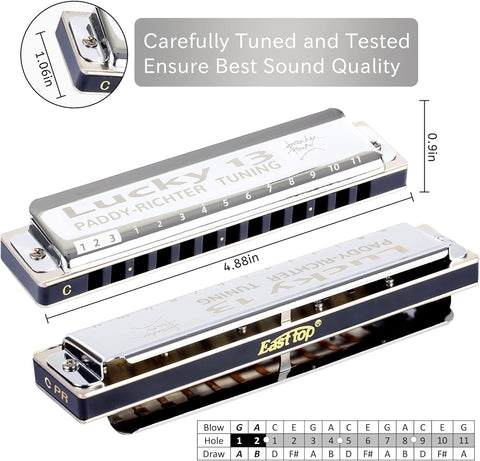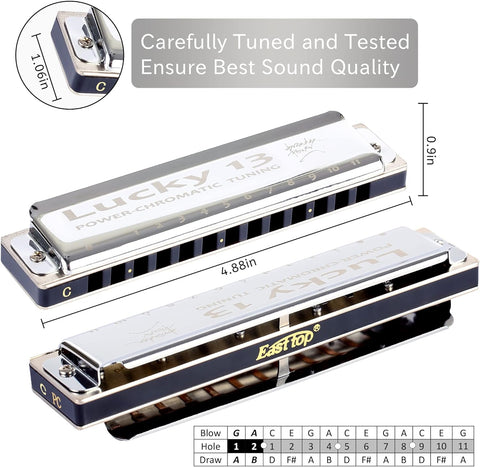L13 Series Harmonica: Choose any three models for a set of three harmonicas, priced at $158 USD
Use Code: L13-3PACK

Diminished Tuning

About this item
- I'm proud to be able to offer the Lucky 13 in Diminished Tuning - the first time this simply brilliant harmonica scale has been offered in an out-of-the-box harp! If you want to play in all 12 keys on one diatonic (as an increasing number of players do),Diminished is undoubtedly the easiest and most logical way to do it.
- The Lucky 13 suits Diminished Tuning perfectly because it gives you a full three octave range - and my unique LOOK-DOTS on the front of the comb mean you will always be able to keep your place with a quick glance!
- It is a symmetrical tuning (every hole has the draw reed one tone above the blow, the next hole always starts one semitone up, and every octave is the same). This means you can instantly transpose phrases into different keys and octaves, simply by moving them to different places on the harp.
- That's particularly helpful for jazz improvisation, where rapid key modulation is essential to get around the chord changes. But Diminished is great for other styles too! As every draw note can be bent a semitone, it's very expressive for playing in any genre: Jazz, Folk, Pop, Country, Blues, Balkan, Middle Eastern... you name it.
- Besides full chromaticism with simple draw bends, the big advantage of Diminished Tuning is that there are ONLY THREE PATTERNS TO LEARN for any scale or lick, in all 12 keys! That makes it way easier than any other diatonic harmonica tuning in existence to transpose your favourite phrases quickly to whatever key you want, without changing harps.WATCH THE VIDEO to get a good flavour of how this Lucky 13 sounds!
Paddy-Richter Tuning

About this item
- Paddy-Richter is one of my many original tunings for harmonica, and has become very popular around the world since I first recorded with it on my 1994 album New Irish Harmonica
- It's great for fast melody playing, especially for Irish and other fiddle tunes, but also good for pop and blues playing.
- Now it's available in an extended range version too! Strictly speaking, it should be called 'Double Paddy-Richter' on the Lucky 13. That's because the normal Paddy Richter low octave scale (with 3 blow tuned up a tone) is repeated an octave lower. This makes the Lucky 13 version great for chords and octaves!
- As with my 10-hole Paddy-Richter harps, the Lucky 13 version is half-valved. Half valving is another invention of mine, an innovation that gives you a lot more soul and volume on the notes you can't normally bend (lower blow notes, upper draws), whilst retaining all the normal bending reeds. If you already like Paddy-Richter, you'll love the Lucky 13 extended version!
- WATCH THE VIDEO to get a good flavour of how this Lucky 13 sounds!
PowerBender Tuning

About this item
- PowerBender is my personal favourite diatonic harp tuning, and it's becoming increasingly popular among players who like to jazz up their playing with easy draw bending technique throughout the whole range of the harp.
- It replaces all the middle octave overblows of Richter with simple draw bends. However,overblows are still available on every single hole to play fully chromatically if you wish. But even with just draw bends, PowerBender allows you to play easily in 11 keys.
- The Lucky 13 version of PowerBender duplicates the low octave to give you awesome low chording and octave possibilities, as well as allowing you to extend your bluesy runs lower down the harp
- The Lucky 13 PowerBender is available in all 12 keys. 4 octave range, draw bends in every hole = Heaven in a Blues Harp!
- WATCH THE VIDEO to get a good flavour of how this Lucky 13 sounds!
PowerChromatic Tuning

About this item
- The extended length of the Lucky 13 lends itself well to harmonica tunings that repeat every four holes, because they need extra holes compared to Richter to achieve the same 3 octave range
- POWER-CHROMATIC is a very expressive repeat-scale tuning I invented for my own use in 1980, and have used ever since. It has only two notes different to Solo tuning, but they have a big effect: now every single draw note can be bent! This makes for great bluesy expression as well as enabling you to play jazzy tunes with ease, using draw bending alone. Many different keys and positions are possible, allowing you to try several and choose the best one for a particular piece.
- The PowerChromatic Lucky 13 is half-valved, giving strong blow notes with the ability to add vibrato and isolated-reed pitch bending, plus all those juicy draw bends in every hole
- PowerChromatic comes in the keys of C, D and G. If you already play PowerBender Tuning, PowerChromatic will be easy to learn - because it is the same scale as holes 4-7 of PowerBender, repeated!
- WATCH THE VIDEO to get a good flavour of how this Lucky 13 sounds!
PowerDraw Tuning

About this item
- This is a great tuning for traditional blues harp players, because it retains ALL the familiar Richter scale in hole 1-6. Plus it gives you an extra bottom octave added on, for easy chord vamping and octaves. Two harps in one!
- Instead of the confusing high octave change of breath pattern in Richter tuning, PowerDraw keeps the same pattern throughout the harp: the draw note is always higher than the blow. This means you can bend all the draw notes in the top octave!
- The high draw bends holes 7-10 are the same notes you can bend lower down the harp, which makes them great for cross-harp Blues style.
- PowerDraw is very easy to learn and gives good tongue-block double-stops for most of the range, plus overblows on every single hole. Now on the Lucky 13 you have all that PLUS the extra low octave, in all 12 keys!
- WATCH THE VIDEO to get a good flavour of how this Lucky 13 sounds!
Standard Richter Tuning

About this item
- World's first 13-hole harp! Exactly 4 octave range in Richter tuning, with lower octave tagged on to normal 10-hole range. The same 7.5mm hole spacing as a normal 10- hole harp! That means it's easy to adapt to. Comfortable smooth coverplates, bottom cover raised at the bass end so the draw reeds never rattle.
- Solid comb, flat-sanded. Look-Dots on the comb, for easy navigation on this larger harp. Durable phosphor-bronze reeds. Thick chromed reedplates, secured with 11 screws for uniform airtightness. Clear visual numbering on top cover relates to the 10- hole diatonic, for familiarity. Available in all 12 keys.
- Key indicators on front and ends of the comb, for those who like to stack harps vertically.
- LACQUERED BLACK COVERPLATES Super smooth in the mouth and looking great
- LOOK-DOTS These handy little position markers on the front of the comb mean you'll never lose your place on this bigger harp.
Solo Tuning

About this item
- The extended length of the Lucky 13 lends itself well to harmonica tunings that repeat every four holes, since they require extra holes to achieve the same 3 octave range as Richter does in a 10-hole harp.
- SOLO TUNING is the best known of these. It is used on 99% of chromatic harmonicas sold, so many players will be familiar with it.
- An excellent tuning for playing pop melodies, it’s also great for playing 3rd Position Blues and Celtic music. It’s actually exactly the same scale as on holes 4-7 on a standard Richter diatonic, so all harp players will instantly feel at home with it. Solo simply repeats that pattern throughout the harp.
- My Lucky 13 in Solo Tuning comes in the keys of C, G and D. It’s half-valved, to give strong, expressive blow notes as well as bendable draw notes on the odd-numbered holes. I chose the popular Orchestra variant of Solo Tuning, where the scale starts a fifth below the tonic note.
- WATCH THE VIDEO to get a good flavour of how this Lucky 13 sounds!


